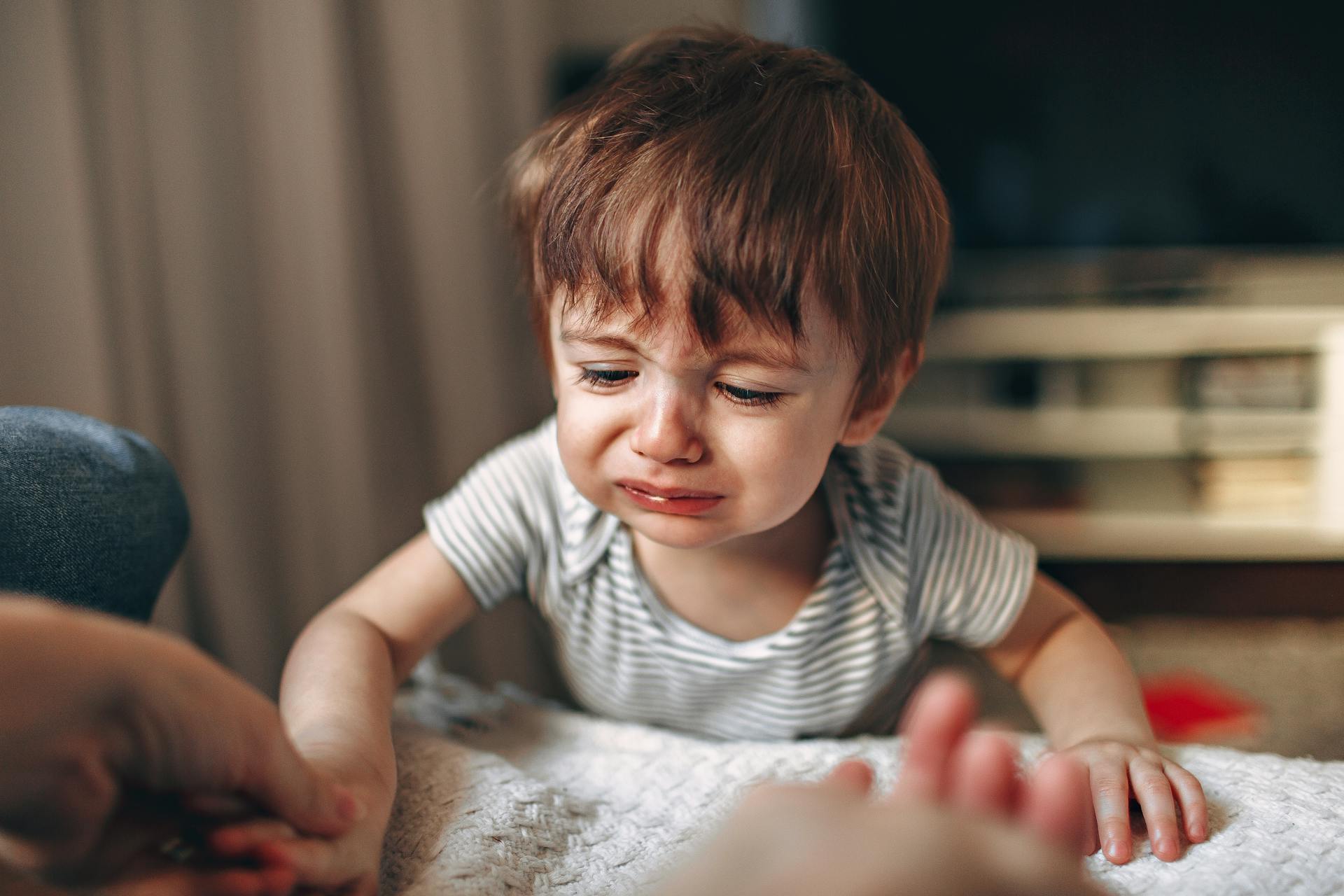
Separation distress is a common issue that affects both dogs and humans, causing feelings of anxiety and distress when separated from each other.
Dogs can suffer from separation anxiety, which can lead to destructive behavior such as chewing or digging.
In fact, studies have shown that dogs can experience separation anxiety as soon as they are weaned from their mothers, around 8-11 weeks old.
This early exposure can lead to long-term attachment issues, making it difficult for dogs to adjust to separation from their owners.
Separation distress in humans is often triggered by past experiences of abandonment or neglect, leading to feelings of insecurity and anxiety when separated from loved ones.
Worth a look: Shih Tzu Barking When Left Alone
What Is Separation Distress
Separation distress, also known as separation anxiety disorder, is a mental health condition that affects children and adults. It causes a person to feel excessive fear or anxiety when separated from a close attachment figure.
The attachment figure is usually a parent, but can be anyone a child has bonded with, such as a grandparent or other caregiver. In adults, the anxiety usually centers on their child or romantic partner.
A child's separation anxiety is considered developmentally expected, but if it persists beyond a certain point, it may be considered a disorder. Symptoms can also appear in adults with or without a history of childhood separation anxiety.
Separation anxiety disorder can get in the way of daily life, causing children to refuse to go to school and adults to miss work or have trouble focusing.
Causes and Risk Factors
Separation anxiety disorder can affect anyone, regardless of age. It's more common in children who experience the loss of someone close to them or go through stressful situations like their parents getting divorced.
Children who have a history of anxiety disorders in their biological family may also be at a higher risk. This can be due to a combination of genetics and environment.
Certain life changes, such as a move or the diagnosis of an anxiety disorder as a child, can also increase the risk of developing separation anxiety disorder as an adult.
Here are some common risk factors for separation anxiety disorder in children and adults:
- Loss of a loved one
- Illness in a loved one
- Big life changes, like a move or entering a romantic relationship
- Diagnosis of an anxiety disorder as a child or adult
- Diagnosis of other anxiety or mental health disorders as an adult
What Causes?
Separation anxiety disorder is a complex issue, and researchers are still figuring out what causes it. Genetics likely play a role, as a person might be born with a genetic change that affects how certain chemicals in their brain work.
A big life change or an adverse childhood experience can also contribute to the development of separation anxiety disorder. This might cause epigenetic changes, which affect how genes work by changing the chemicals attached to them.
Genetics alone might not be enough to cause a disorder, suggesting that environment plays a significant part.
Risk Factors
Separation anxiety disorder can affect anyone, regardless of age. If you're wondering what might increase your risk, let's take a closer look.
Experience is a big factor. A child may have an increased risk of developing separation anxiety disorder if they experience the loss of someone close to them, go through a stressful situation like their parents getting divorced, switch schools or move to a new place, or have a history of anxiety disorders in their biological family.
Genetics also play a role. A person might be born with a genetic change (mutation) that affects how certain chemicals in their brain work.
Life changes can trigger separation anxiety in adults. These can include loss of a loved one, illness in a loved one, big life changes like a move, entering a romantic relationship and becoming a parent, diagnosis of an anxiety disorder as a child, or diagnosis of other anxiety or mental health disorders as an adult.
Here are some specific risk factors for separation anxiety disorder:
- Loss of a loved one.
- Illness in a loved one.
- Big life changes, like a move, entering a romantic relationship and becoming a parent.
- Diagnosis of an anxiety disorder as a child.
- Diagnosis of other anxiety or mental health disorders as an adult.
It's not just about genetics or environment. It's likely a combination of both. For example, a person might be born with a genetic change, but it's an environmental factor like a big life change that triggers the disorder.
Symptoms and Causes
Symptoms of separation anxiety can be distressing to witness, whether it's in our furry friends or our little ones. Dogs with separation anxiety exhibit a range of behaviors, including trembling or salivating, digging and scratching at doors or windows, and destructive chewing.

Some common symptoms of separation anxiety in children include excessive distress when separated from home or family, constant worry about something bad happening to a loved one, and reluctance to be home alone or without a parent in the house.
Dogs may also exhibit physical symptoms such as urination and defecation, even with otherwise house-trained dogs. These behaviors are a clear indication that something is amiss and needs attention.
The following list highlights some of the key symptoms of separation anxiety in children:
- Excessive distress when separated from home or family
- Constant worry about something bad happening to a loved one
- Reluctance to be home alone or without a parent in the house
- Frequent checking to learn a parent's whereabouts or needing reassurance that they are available
- Excessive "clinginess", even when home
- Frequent complaints of stomachaches, headaches and other physical symptoms before anticipated separation from parent/guardian
- Panic and/or temper tantrums when separated from parents/caregivers
It's essential to recognize these symptoms early on and seek help to address the underlying causes of separation anxiety.
How Common Is?
Separation anxiety disorder is more common than you might think. It's the most common anxiety disorder in children under age 12, affecting about 4 in 100 kids in this age group.
In adults, the numbers are smaller, but still significant, with around 1% to 2% of the US population affected, which translates to about 1 in 50 adults.
Symptoms and Diagnosis
Symptoms of separation distress can vary depending on the individual, but some common signs include trembling or salivating, digging and scratching at doors or windows, and destructive chewing. These behaviors are often accompanied by howling, barking, or whining.
Dogs with separation anxiety may also exhibit destructive behaviors like urination and defecation, even if they're otherwise house-trained. They may become frantic and clingy when their owners are preparing to leave the house.
If you're wondering if your dog has separation anxiety, look for behaviors that occur when they're left alone, such as following you from room to room or displaying effusive, frantic greeting behaviors. They may also react with excitement, depression, or anxiety to your preparations to leave the house.
According to the Diagnostic and Statistical Manual of Mental Disorders, Fifth Edition (DSM-5-TR), a diagnosis of separation anxiety may be reached if all of the following are true:
- The person has at least three of the eight possible symptoms.
- The symptoms are persistent, lasting for at least four weeks in children or six months in adults.
- The symptoms cause the person much distress or interfere with their daily functioning.
- Another diagnosis isn’t responsible for these symptoms.
Children with separation anxiety disorder may exhibit excessive distress when separated from home or family, constant worry that something bad will happen to a loved one, and excessive worry about losing a parent/guardian. They may also show reluctance or refusal to leave home without a parent/guardian, or frequent checking to learn a parent's whereabouts or needing reassurance that they are available.
Symptoms of separation anxiety disorder can be diagnosed through a combination of a doctor talking to you about your symptoms and asking you to fill out a questionnaire or a set of questions focused on your symptoms and experiences.
See what others are reading: Home Remedies for Separation Anxiety in Dogs
Treatment and Prevention
The first-line treatment for separation anxiety disorder is talk therapy, specifically cognitive behavioral therapy (CBT), which helps a person understand how their thoughts affect their actions.
CBT can be combined with other forms of therapy, such as dialectical behavioral therapy (DBT) and family therapy, which can improve relationships among family members and educate everyone about separation anxiety disorder.
If you're experiencing symptoms of separation anxiety disorder, contact a healthcare provider right away. They can help you develop a treatment plan that works for you.
If your healthcare provider prescribes medication, be sure to let them know if you notice any new or changing side effects, behavioral changes, or if your symptoms aren't improving or are getting worse.
In some cases, treating separation anxiety can take months, and it's not uncommon for behaviors to resurface during times of transition.
What Won't Help a Problem
Punishment is not an effective way to treat separation anxiety in dogs. It may even make the problem worse by causing your dog to associate your return home with negative consequences.
Crating your dog won't help either. Your dog will still experience anxiety responses in the crate, such as urinating, defecating, howling, or even injuring themselves in an attempt to escape.
Leaving the radio on is not a solution. Unless you're using the radio as a "safety cue", it's not going to calm your dog's separation anxiety.
Obedience school is not a direct solution to separation anxiety. It's not a matter of disobedience or lack of training, but rather a panic response that needs to be addressed specifically.
Here are some common misconceptions about treating separation anxiety:
- Punishment: Don't try to correct your dog's behavior after you return home.
- Crating: It won't calm your dog's anxiety, and may even make things worse.
- Radio: Unless it's a safety cue, it's not a solution.
- Obedience school: It won't directly help with separation anxiety.
Medications
Medications can be a helpful addition to talk therapy for managing separation anxiety disorder.
For children aged 6 or older, selective serotonin reuptake inhibitors (SSRIs) are sometimes used to treat separation anxiety disorder. These medications include Fluoxetine (Prozac), Sertraline (Zoloft), and Paroxetine (Paxil, Pexeva).
Possible side effects of SSRIs in children include insomnia, vomiting, and changes in appetite. There is also a risk of increased suicidal ideation, so close monitoring by a healthcare provider is essential.

In adults, medications like SSRIs or anti-anxiety medications like benzodiazepines may be prescribed. However, benzodiazepines can be habit-forming, and SSRIs may increase the risk of suicidal thoughts or behavior, especially when first starting them.
Here are some common medications used to treat separation anxiety disorder in children and adults:
It's essential to discuss any concerns or questions you have with your healthcare provider before starting medication.
Is Preventable?
Prevention is key, but unfortunately, there's no known way to prevent separation anxiety disorder.
Establishing a strong relationship with your child through open dialogue can go a long way in supporting their mental health. Let them know they can talk to you about anything that's on their mind at any time.
Reassuring your child that you'll be there for them, even when you're not physically present, can provide a sense of security and comfort. You can reassure them that you're just a phone call away.
Talking to your pediatrician about ways to ease your child's transition into school and other activities away from home can also be helpful.
Frequently Asked Questions
At what age does separation anxiety typically peak?
Separation anxiety typically peaks between 10 and 18 months of age. This common phase of development usually resolves by the time a child reaches 3 years old.
Sources
- https://www.humanesociety.org/resources/separation-anxiety-dogs
- https://www.ddfl.org/resources/separation-anxiety/
- https://my.clevelandclinic.org/health/diseases/23142-separation-anxiety
- https://pubmed.ncbi.nlm.nih.gov/7633137/
- https://www.chop.edu/news/health-tip/separation-anxiety-whats-normal-and-when-worry
Featured Images: pexels.com


